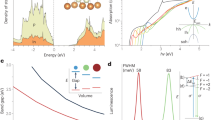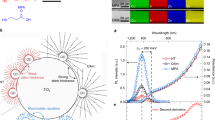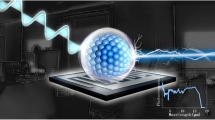Abstract
Colloidal-quantum-dot (CQD) optoelectronics offer a compelling combination of solution processing and spectral tunability through quantum size effects. So far, CQD solar cells have relied on the use of organic ligands to passivate the surface of the semiconductor nanoparticles. Although inorganic metal chalcogenide ligands have led to record electronic transport parameters in CQD films, no photovoltaic device has been reported based on such compounds. Here we establish an atomic ligand strategy that makes use of monovalent halide anions to enhance electronic transport and successfully passivate surface defects in PbS CQD films. Both time-resolved infrared spectroscopy and transient device characterization indicate that the scheme leads to a shallower trap state distribution than the best organic ligands. Solar cells fabricated following this strategy show up to 6% solar AM1.5G power-conversion efficiency. The CQD films are deposited at room temperature and under ambient atmosphere, rendering the process amenable to low-cost, roll-by-roll fabrication.
This is a preview of subscription content, access via your institution
Access options
Subscribe to this journal
Receive 12 print issues and online access
$259.00 per year
only $21.58 per issue
Buy this article
- Purchase on SpringerLink
- Instant access to full article PDF
Prices may be subject to local taxes which are calculated during checkout





Similar content being viewed by others
References
Konstantatos, G. et al. Ultrasensitive solution-cast quantum dot photodetectors. Nature 442, 180–183 (2006).
Konstantatos, G., Clifford, J., Levina, L. & Sargent, E. H. Sensitive solution-processed visible-wavelength photodetectors. Nature Photon. 1, 531–534 (2007).
Sukhovatkin, V., Hinds, S., Brzozowski, L. & Sargent, E. H. Colloidal quantum-dot photodetectors exploiting multiexciton generation. Science 324, 1542–1544 (2009).
Coe, S., Woo, W. K., Bawendi, M. & Bulovic, V. Electroluminescence from single monolayers of nanocrystals in molecular organic devices. Nature 420, 800–803 (2002).
Klimov, V. I. et al. Optical gain and stimulated emission in nanocrystal quantum dots. Science 290, 314–317 (2000).
Tang, J. A. & Sargent, E. H. Infrared colloidal quantum dots for photovoltaics: Fundamentals and recent progress. Adv. Mater. 23, 12–29 (2011).
Henry, C. H. Limiting efficiencies of ideal single and multiple energy-gap terrestrial solar-cells. J. Appl. Phys. 51, 4494–4500 (1980).
King, R. R. Multijunction cells—record breakers. Nature Photon. 2, 284–286 (2008).
Murray, C. B., Kagan, C. R. & Bawendi, M. G. Synthesis and characterization of monodisperse nanocrystals and close-packed nanocrystal assemblies. Annu. Rev. Mater. Sci. 30, 545–610 (2000).
Klem, E. J. D. et al. Impact of dithiol treatment and air annealing on the conductivity, mobility, and hole density in PbS colloidal quantum dot solids. Appl. Phys. Lett. 92, 212105 (2008).
Luther, J. M. et al. Schottky solar cells based on colloidal nanocrystal films. Nano Lett. 8, 3488–3492 (2008).
Koleilat, G. I. et al. Efficient, stable infrared photovoltaics based on solution-cast colloidal quantum dots. ACS Nano 2, 833–840 (2008).
Talapin, D. V. & Murray, C. B. PbSe nanocrystal solids for n- and p-channel thin film field-effect transistors. Science 310, 86–89 (2005).
Pattantyus-Abraham, A. G. et al. Depleted-heterojunction colloidal quantum dot solar cells. ACS Nano 4, 3374–3380 (2010).
Kovalenko, M. V., Scheele, M. & Talapin, D. V. Colloidal nanocrystals with molecular metal chalcogenide surface ligands. Science 324, 1417–1420 (2009).
Kovalenko, M. V., Bodnarchuk, M. I., Zaumseil, J., Lee, J. S. & Talapin, D. V. Expanding the chemical versatility of colloidal nanocrystals capped with molecular metal chalcogenide ligands. J. Am. Chem. Soc. 132, 10085–10092 (2010).
Lee, J. S., Kovalenko, M. V., Huang, J., Chung, D. S. & Talapin, D. V. Band-like transport, high electron mobility and high photoconductivity in all-inorganic nanocrystal arrays. Nature Nanotech. 6, 348–352 (2011).
Bryant, G. W. & Jaskolski, W. Surface effects on capped and uncapped nanocrystals. J. Phys. Chem. B 109, 19650–19656 (2005).
Gai, Y. Q., Peng, H. W. & Li, J. B. Electronic properties of nonstoichiometric PbSe quantum dots from first principles. J. Phys. Chem. C 113, 21506–21511 (2009).
Owen, J. S., Park, J., Trudeau, P. E. & Alivisatos, A. P. Reaction chemistry and ligand exchange at cadmium–selenide nanocrystal surfaces. J. Am. Chem. Soc. 130, 12279–12280 (2008).
Tang, J. et al. Quantum dot photovoltaics in the extreme quantum confinement regime: The surface-chemical origins of exceptional air- and light-stability. ACS Nano 4, 869–878 (2010).
Fernee, M. J. et al. Inorganic surface passivation of PbS nanocrystals resulting in strong photoluminescent emission. Nanotechnology 14, 991–997 (2003).
Pietryga, J. M. et al. Utilizing the lability of lead selenide to produce heterostructured nanocrystals with bright, stable infrared emission. J. Am. Chem. Soc. 130, 4879–4885 (2008).
Robinson, R. D. et al. Spontaneous superlattice formation in nanorods through partial cation exchange. Science 317, 355–358 (2007).
Schapotschnikow, P., Hommersom, B. & Vlugt, T. J. H. Adsorption and binding of ligands to CdSe nanocrystals. J. Phys. Chem. C 113, 12690–12698 (2009).
Fritzinger, B., Capek, R. K., Lambert, K., Martins, J. C. & Hens, Z. Utilizing self-exchange to address the binding of carboxylic acid ligands to CdSe quantum dots. J. Am. Chem. Soc. 132, 10195–10201 (2010).
Luther, J. M. et al. Structural, optical and electrical properties of self-assembled films of PbSe nanocrystals treated with 1,2-ethanedithiol. ACS Nano 2, 271–280 (2008).
Zhao, N. et al. Colloidal PbS quantum dot solar cells with high fill factor. ACS Nano 4, 3743–3752 (2010).
Hanrath, T., Choi, J. J. & Smilgies, D. M. Structure/processing relationships of highly ordered lead salt nanocrystal superlattices. ACS Nano 3, 2975–2988 (2009).
Moreels, I., Fritzinger, B., Martins, J. C. & Hens, Z. Surface chemistry of colloidal PbSe nanocrystals. J. Am. Chem. Soc. 130, 15081–15086 (2008).
Nefedov, V. I. A comparison of results of an ESCA study of nonconducting solids using spectrometers of different constructions. J. Electron Spectrosc. Relat. Phenom. 25, 29–47 (1982).
Kang, M. S., Lee, J., Norris, D. J. & Frisbie, C. D. High carrier densities achieved at low voltages in ambipolar PbSe nanocrystal thin-film transistors. Nano Lett. 9, 3848–3852 (2009).
Liu, Y. et al. Dependence of carrier mobility on nanocrystal size and ligand length in PbSe nanocrystal solids. Nano Lett. 10, 1960–1969 (2010).
Luther, J. M. et al. Stability assessment on a 3% bilayer PbS/ZnO quantum dot heterojunction solar cell. Adv. Mater. 22, 3704–3707 (2010).
Zaban, A., Meier, A. & Gregg, B. A. Electric potential distribution and short-range screening in nanoporous TiO2 electrodes. J. Phys. Chem. B 101, 7985–7990 (1997).
Zhong, H. Z. et al. Noninjection gram-scale synthesis of monodisperse pyramidal CuInS2 nanocrystals and their size-dependent properties. ACS Nano 4, 5253–5262 (2010).
Zhang, J. & Jiang, X. M. Confinement-dependent below-gap state in PbS quantum dot films probed by continuous-wave photoinduced absorption. J. Phys. Chem. B 112, 9557–9560 (2008).
Guyot-Sionnest, P., Shim, M., Matranga, C. & Hines, M. Intraband relaxation in CdSe quantum dots. Phys. Rev. B 60, R2181–R2184 (1999).
Riedel, I. et al. Effect of temperature and illumination on the electrical characteristics of polymer-fullerene bulk-heterojunction solar cells. Adv. Funct. Mater. 14, 38–44 (2004).
Clifford, J. P. et al. Fast, sensitive and spectrally tuneable colloidal quantum-dot photodetectors. Nature Nanotech. 4, 40–44 (2009).
Acknowledgements
This publication is based in part on work supported by Award No. KUS–11–009-21, made by King Abdullah University of Science and Technology (KAUST). We thank Angstrom Engineering and Innovative Technologies for useful discussions concerning material deposition methods and control of the glovebox environment, respectively. The authors thank H. Zhong, R. Li, L. Brzozowski, V. Sukhovatkin, A. Barkhouse, I. Kramer, G. Koleilat, E. Palmiano and R. Wolowiec for their help during the course of study. R.D. acknowledges the financial support of e8 scholarship. K.S.J. and J.B.A. gratefully acknowledge partial support from the Petroleum Research Fund (PRF #49639-ND6), the National Science Foundation (CHE 0846241), and the Office of Naval Research (N00014-11-1-0239).
Author information
Authors and Affiliations
Contributions
J.T. and E.H.S. designed and directed this study and analysed the experimental results. J.T. contributed to all the experimental work. K.W.K. and S.H. carried out the photodiode work and K.W.K. assisted in all the experimental work. K.S.J. and J.B.A. carried out the TRIR experiments and analysed the data. H.L. fabricated the TiO2 electrodes. L.L. synthesized the PbS CQDs. K.W.K., L.L. and R.D. contributed to the solution Cd treatment experiment. D.C, K.W.C. and A.A. carried out the GISAXS and TEM measurements and analysed the data. S.H., M.F., X.W., H.L., A.F. and R.D. assisted in device fabrication and characterization. J.T., J.B.A. and E.H.S. wrote the manuscript. All authors commented on the paper.
Corresponding author
Ethics declarations
Competing interests
The authors declare no competing financial interests.
Supplementary information
Supplementary Information
Supplementary Information (PDF 3343 kb)
Rights and permissions
About this article
Cite this article
Tang, J., Kemp, K., Hoogland, S. et al. Colloidal-quantum-dot photovoltaics using atomic-ligand passivation. Nature Mater 10, 765–771 (2011). https://doi.org/10.1038/nmat3118
Received:
Accepted:
Published:
Issue Date:
DOI: https://doi.org/10.1038/nmat3118
This article is cited by
-
How to improve the structural stabilities of halide perovskite quantum dots: review of various strategies to enhance the structural stabilities of halide perovskite quantum dots
Nano Convergence (2024)
-
Positron annihilation spectroscopic studies of ferromagnetic methylammonium lead iodide perovskite
Journal of Materials Science (2024)
-
Optimized polarization-independent Chand-Bali nano-antenna for thermal IR energy harvesting
Scientific Reports (2023)
-
A robust and unique approach for tuning the energy level of Ag2Se quantum dots via “on-surface” manipulation of nitrogen-containing groups of surface-coordinated ligands
Nano Research (2023)
-
Efficient single-component white light emitting diodes enabled by lanthanide ions doped lead halide perovskites via controlling Förster energy transfer and specific defect clearance
Light: Science & Applications (2022)



